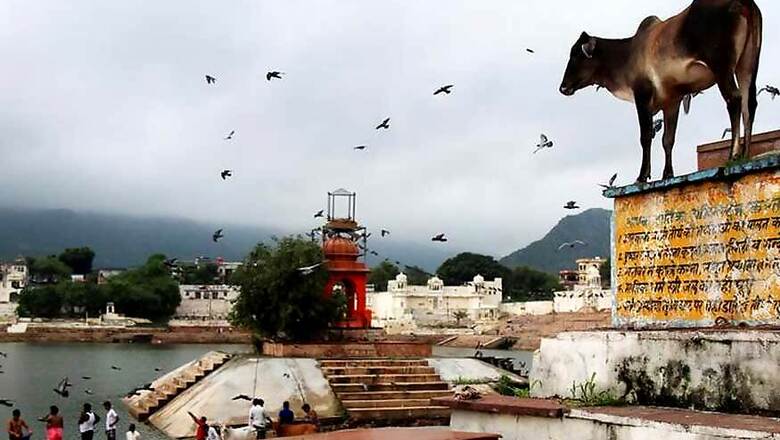
views
New Delhi: In May last year, the Union government imposed a ban on cattle slaughter, which was rolled back later. This and reports of cow vigilantes targeting cattle transporters in different parts of the country put the focus on the 'holy cow.'
A restriction to slaughter cows is enshrined in the Constitution under Directive Principles of State Policy which is not binding.
As India, marks the 70th year of adopting the Constitution on Friday, News18 looks at how the cow issue had featured in the Constituent Assembly debates.
In 1947, just a day before India attained Independence, Vishwambhar Dayalu Tripathi told the Assembly that it was necessary that cow protection is ensured within the framework of the constitution.
Tripathi, chairman of the Zamindari Abolition Commission, said, “Cow protection is very important for an agricultural country. I am happy that a resolution to this effect is coming before you. I hope that this Assembly will adopt it unanimously. Not only from financial point of view but from cultural point of view also, I think it is necessary to make adequate arrangements for cow protection,” Tripathi had said.
In the same 1946 debate, while discussing Article 48 of the constitution, another Constituent Assembly member JJM Nichols Roy had recollected how western countries perceived Indians as “steeped in caste system and cow worshippers.”
“When I was in England and America, I was impressed by the fact that some people had an idea that a Hindu is a man who is steeped in his caste system and who worships a cow. If this is the idea which Viscount Simon has when he refers to a Hindu Raj'...then he is entirely wrong,” Roy had opined.
A year later, the strongest support for cow protection being made a fundamental right came from Congress leader Thakur Das Bhargava who struck a difference between “useful” and non-useful “breeds of cattle.”
“If you want rivers of milk and honey to flow in India, we should also say that the Government shall preserve, protect and improve the useful breeds of cattle, and ban the slaughter of useful cattle,” he said.
Bhargava had moved an amendment to the draft provision and it determined the shape in which Article 48 stands today, “The State shall endeavour to organise agriculture and animal husbandry on modern and scientific lines and shall, in particular, take steps for preserving and improving the breeds, and prohibiting the slaughter, of cows and calves and other milch and draught cattle.”
Drawing international examples, Bhargava said countries who do not even consider cow as a sacred animal had banned its slaughter for economic issues.
“In Burma, which has got no religion like ours and do not regard cow as sacred, they have banned cows. I do not want that. What I want is that the slaughter of useful cattle shall be banned,” said Bhargava.
This point was specifically dealt by the Supreme Court in 1958 in the Mohd Qureshi case where a five-judge bench partly upheld the validity of the laws, as far as they banned slaughter of cows and calves.
However, it said these laws were “void in so far as they totally prohibit the slaughter of breeding bulls and working bullocks without prescribing any test or requirement as to their age or usefulness“. It said a law enacted to honour a Directive Principle provision could not violate fundamental rights.
This sudden increase in attacks against Muslims over cattle trade and beef consumption seems misplaced as it was a Muslim who had addressed the assembly stating that they approve a ban on cow-slaughter in the 1940s.
The only condition according to the Muslim member from Assam was that Constitution must explicitly suggest that such a ban was there to satiate the Hindu religious sentiments and that it was not for economic reasons.
“I do not want to obstruct the framers of our Constitution if they come out in the open and say directly: This is part of our religion. The cow should be protected from slaughter and therefore we want its provision either in the Fundamental Rights or in the Directive Principles ... But, those who put it on the economic front ... do create a suspicion in the minds of many that the ingrained Hindu feeling against cow slaughter is being satisfied by the backdoor,” said Syed Muhammad Sa’adulla.
As India continues to debate a ban on cow slaughter, one of the most critiqued positions have been the inadequate shelter arrangements for stray cattle who are no longer needed.
Just last year, Madhya Pradesh, which accounts for 10.27 percent of the country’s cattle population, was battling with the menace of stray cattle. MP has nearly 1.96 crore cattle but there is no estimate of the stray population.
This problem was also foreseen by the Constituent Assembly members who thought of this menace as a “terrible burden” on any country.
In 1948, JJM Nichols Roy said that banning cow slaughter would be terrible burden for the state.
“I was wondering whether the provision would mean the prohibition of cow slaughter at all times and of every kind of cattle. It would place a terrible burden on the State. Think of the millions of cows that will float round the country without any fodder, and sickly, and the amount of money that will be spent on them,” Roy said.
















Comments
0 comment